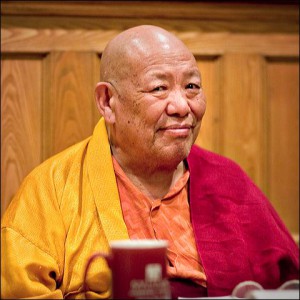Lama Tsering Wangdu Rinpoche was born in 1935 in the Langkor Valley in West Tingri, Tibet. The region was the Tibetan home of Padampa Sangye, the founder of the Shije and Machik Labdron, the founder of Chod. Lama Wangdu Rinpoche began studying with his root lama, Naptra Rinpoche, at age 8. After years of practice, his guru sent him on a traditional Chod retreat, during which he practiced Chod in 108 charnel grounds. On his return, his teacher acknowledged his accomplishment, gave him further instruction and in 1958, sent him on pilgrimage to Nepal. When the Chinese closed the Tibetan border in 1959, a trip that was to last one year became exile; Rinpoche has not been able to return to Tibet.
Rinpoche made his way to the Kathmandu Valley, where he settled in the Tibetan refugee camp in Jawalakehl. He lived there for many years, and as one of the few Nyingma ritual practitioners accessible to both Tibetan refugees and Nepalis, became well known as a Chodpa and healer throughout Nepal. In addition to serving as a spiritual leader for the Tibetan community, Rinpoche spent significant time in retreat, and received teachings and empowerments from the Dalai Lama, Dudjom Rinpoche, Surkhang Rinpoche, Urgyen Tulku, and Chatral Rinpoche. Today he is recognized as a lineage holder of Padampa Sangye’s Shije, numerous Chod lineages, and the Longchen Nyingthig.
In 1999, Rinpoche made his first trip to the United States to attend the Kalachakra initiation and visit the Movement Center in Portland, Oregon. He now spends part of each year in Portland, practicing Chod with the local community, teaching Chod, Phowa and practices from the Longchen Nyinthig, and guiding a growing group of lay practitioners. While in the United States, he also supports the translation of the texts he has transmitted to his students, including teachings from the Shije tradition.
In 2003, Rinpoche attended teachings by His Holiness the XIV Dalai Lama in Dharamsala, India. During that visit, His Holiness told him that teachings of Padampa Sangye and Machik Labdron, especially the practices for the pacification of suffering, were precious and needed to be preserved. Recognizing Rinpoche as an eminent lineage holder of Shije and Chod, His Holiness asked him to establish a monastery, transmit these teachings to a new generation of practitioners, and preserve the Shije and Chod lineages for the benefit of all beings.
On his return to Nepal, Rinpoche acquired and renovated an old monastery in Boudha near the Great Stupa. The monastery, called Pal Gyi Tingri Langkor Jangsem Kung Ling, opened in 2004 and was home to a monastic community of monks trained in the Shije, Chod, and the Longchen Nyingthig.
Alongside the monks, lay practitioners from all over the world came to study Chod, learn the yogic songs and dances of the tradition, and participate in daily practice. Twice each month, Rinpoche offered a Chod feast for the community. He also held a daily public audience that attracted hundreds of people.
Although Rinpoche retired as Abbot of Pal Gyi Ling monastery to spend time in retreat, he continued to serve as a healer and spiritual guide for countless people in Nepal and the United States. As one of the few remaining Tibetan lamas who trained and practiced in pre-occupied Tibet, he was committed to preserving and transmitting the authentic and rare teachings he received and brought to fruition through decades of practice.
You can learn more about Lama Wangdu’s life in Tibet and Nepal by reading his autobiography, One Hundred Thousand Rays of the Sun.



